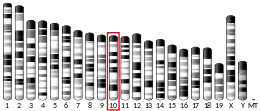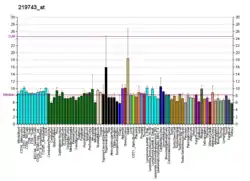Hairy/enhancer-of-split related with YRPW motif protein 2 (HEY2) also known as cardiovascular helix-loop-helix factor 1 (CHF1) is a protein that in humans is encoded by the HEY2 gene.[5][6]
This protein is a type of transcription factor that belongs to the hairy and enhancer of split-related (HESR) family of basic helix-loop-helix (bHLH)-type transcription factors. It forms homo- or hetero-dimers that localize to the nucleus and interact with a histone deacetylase complex to repress transcription. During embryonic development, this mechanism is used to control the number of cells that develop into cardiac progenitor cells and myocardial cells. [7] The relationship is inversely related, so as the number of cells that express the Hey2 gene increases, the more CHF1 is present to repress transcription and the number of cells that take on a myocardial fate decreases. [7]
Expression
The expression of the Hey2 gene is induced by the Notch signaling pathway. In this mechanism, adjacent cells bind via transmembrane notch receptors. Two similar and redundant genes in mouse are required for embryonic cardiovascular development, and are also implicated in neurogenesis and somitogenesis. Alternatively spliced transcript variants have been found, but their biological validity has not been determined.[6]
Knockout studies
The Hey2 gene is involved with the formation of the cardiovascular system and especially the heart itself. [7] Although studies have not been conducted about the effects of a malfunction in Hey2 expression in humans, experiments done with mice suggest this gene could be responsible for a number of heart defects. Using a gene knockout technique, scientists inactivated both the Hey1 and Hey2 genes of mice.[8] The loss of these two genes resulted in death of the embryo 9.5 days after conception.[8] It was found that the developing hearts of these embryos lacked most structural formations which resulted in massive hemorrhage.[8] When only the Hey1 gene was knocked out, no apparent phenotypic changes occurred, suggesting that these two genes carry similar and redundant information for the development of the heart.[8]
Clinical significance
Common variants of SCN5A, SCN10A, and HEY2 (this gene) are associated with Brugada syndrome.[9]
Interactions
HEY2 has been shown to interact with Sirtuin 1[10] and Nuclear receptor co-repressor 1.[11]
References
- 1 2 3 GRCh38: Ensembl release 89: ENSG00000135547 - Ensembl, May 2017
- 1 2 3 GRCm38: Ensembl release 89: ENSMUSG00000019789 - Ensembl, May 2017
- ↑ "Human PubMed Reference:". National Center for Biotechnology Information, U.S. National Library of Medicine.
- ↑ "Mouse PubMed Reference:". National Center for Biotechnology Information, U.S. National Library of Medicine.
- ↑ Leimeister C, Externbrink A, Klamt B, Gessler M (July 1999). "Hey genes: a novel subfamily of hairy- and Enhancer of split related genes specifically expressed during mouse embryogenesis". Mechanisms of Development. 85 (1–2): 173–7. doi:10.1016/S0925-4773(99)00080-5. PMID 10415358. S2CID 17342136.
- 1 2 "Entrez Gene: HEY2 hairy/enhancer-of-split related with YRPW motif 2".
- 1 2 3 Gibb N, Lazic S, Yuan X, Deshwar AR, Leslie M, Wilson MD, Scott IC (November 2018). "Hey2 regulates the size of the cardiac progenitor pool during vertebrate heart development". Development. 145 (22): dev167510. doi:10.1242/dev.167510. PMID 30355727.
- 1 2 3 4 Fischer A, Schumacher N, Maier M, Sendtner M, Gessler M (April 2004). "The Notch target genes Hey1 and Hey2 are required for embryonic vascular development". Genes & Development. 18 (8): 901–11. doi:10.1101/gad.291004. PMC 395849. PMID 15107403.
- ↑ Bezzina CR, Barc J, Mizusawa Y, Remme CA, Gourraud JB, Simonet F, et al. (September 2013). "Common variants at SCN5A-SCN10A and HEY2 are associated with Brugada syndrome, a rare disease with high risk of sudden cardiac death". Nature Genetics. 45 (9): 1044–9. doi:10.1038/ng.2712. PMC 3869788. PMID 23872634.
- ↑ Takata T, Ishikawa F (January 2003). "Human Sir2-related protein SIRT1 associates with the bHLH repressors HES1 and HEY2 and is involved in HES1- and HEY2-mediated transcriptional repression". Biochemical and Biophysical Research Communications. 301 (1): 250–7. doi:10.1016/S0006-291X(02)03020-6. PMID 12535671.
- ↑ Iso T, Sartorelli V, Poizat C, Iezzi S, Wu HY, Chung G, et al. (September 2001). "HERP, a novel heterodimer partner of HES/E(spl) in Notch signaling". Molecular and Cellular Biology. 21 (17): 6080–9. doi:10.1128/MCB.21.17.6080-6089.2001. PMC 87325. PMID 11486045.
Further reading
- Iso T, Kedes L, Hamamori Y (March 2003). "HES and HERP families: multiple effectors of the Notch signaling pathway". Journal of Cellular Physiology. 194 (3): 237–55. doi:10.1002/jcp.10208. PMID 12548545. S2CID 6463286.
- Kokubo H, Miyagawa-Tomita S, Johnson RL (July 2005). "Hesr, a mediator of the Notch signaling, functions in heart and vessel development". Trends in Cardiovascular Medicine. 15 (5): 190–4. doi:10.1016/j.tcm.2005.05.005. PMID 16165016.
- Chin MT, Maemura K, Fukumoto S, Jain MK, Layne MD, Watanabe M, Hsieh CM, Lee ME (March 2000). "Cardiovascular basic helix loop helix factor 1, a novel transcriptional repressor expressed preferentially in the developing and adult cardiovascular system". The Journal of Biological Chemistry. 275 (9): 6381–7. doi:10.1074/jbc.275.9.6381. PMID 10692439.
- Zhong TP, Rosenberg M, Mohideen MA, Weinstein B, Fishman MC (March 2000). "gridlock, an HLH gene required for assembly of the aorta in zebrafish". Science. 287 (5459): 1820–4. Bibcode:2000Sci...287.1820Z. doi:10.1126/science.287.5459.1820. PMID 10710309.
- Steidl C, Leimeister C, Klamt B, Maier M, Nanda I, Dixon M, Clarke R, Schmid M, Gessler M (June 2000). "Characterization of the human and mouse HEY1, HEY2, and HEYL genes: cloning, mapping, and mutation screening of a new bHLH gene family". Genomics. 66 (2): 195–203. doi:10.1006/geno.2000.6200. PMID 10860664.
- Firulli BA, Hadzic DB, McDaid JR, Firulli AB (October 2000). "The basic helix-loop-helix transcription factors dHAND and eHAND exhibit dimerization characteristics that suggest complex regulation of function". The Journal of Biological Chemistry. 275 (43): 33567–73. doi:10.1074/jbc.M005888200. PMC 2561327. PMID 10924525.
- Nakagawa O, McFadden DG, Nakagawa M, Yanagisawa H, Hu T, Srivastava D, Olson EN (December 2000). "Members of the HRT family of basic helix-loop-helix proteins act as transcriptional repressors downstream of Notch signaling". Proceedings of the National Academy of Sciences of the United States of America. 97 (25): 13655–60. Bibcode:2000PNAS...9713655N. doi:10.1073/pnas.250485597. PMC 17631. PMID 11095750.
- Iso T, Sartorelli V, Chung G, Shichinohe T, Kedes L, Hamamori Y (September 2001). "HERP, a new primary target of Notch regulated by ligand binding". Molecular and Cellular Biology. 21 (17): 6071–9. doi:10.1128/MCB.21.17.6071-6079.2001. PMC 87324. PMID 11486044.
- Iso T, Sartorelli V, Poizat C, Iezzi S, Wu HY, Chung G, Kedes L, Hamamori Y (September 2001). "HERP, a novel heterodimer partner of HES/E(spl) in Notch signaling". Molecular and Cellular Biology. 21 (17): 6080–9. doi:10.1128/MCB.21.17.6080-6089.2001. PMC 87325. PMID 11486045.
- Takata T, Ishikawa F (January 2003). "Human Sir2-related protein SIRT1 associates with the bHLH repressors HES1 and HEY2 and is involved in HES1- and HEY2-mediated transcriptional repression". Biochemical and Biophysical Research Communications. 301 (1): 250–7. doi:10.1016/S0006-291X(02)03020-6. PMID 12535671.
- Fischer A, Klamt B, Schumacher N, Glaeser C, Hansmann I, Fenge H, Gessler M (September 2004). "Phenotypic variability in Hey2 -/- mice and absence of HEY2 mutations in patients with congenital heart defects or Alagille syndrome". Mammalian Genome. 15 (9): 711–6. doi:10.1007/s00335-004-2389-x. PMID 15389319. S2CID 1783083.
- Kokubo H, Miyagawa-Tomita S, Nakazawa M, Saga Y, Johnson RL (February 2005). "Mouse hesr1 and hesr2 genes are redundantly required to mediate Notch signaling in the developing cardiovascular system". Developmental Biology. 278 (2): 301–9. doi:10.1016/j.ydbio.2004.10.025. PMID 15680351.
- Doi H, Iso T, Yamazaki M, Akiyama H, Kanai H, Sato H, et al. (November 2005). "HERP1 inhibits myocardin-induced vascular smooth muscle cell differentiation by interfering with SRF binding to CArG box". Arteriosclerosis, Thrombosis, and Vascular Biology. 25 (11): 2328–34. doi:10.1161/01.ATV.0000185829.47163.32. PMID 16151017.
- Rual JF, Venkatesan K, Hao T, Hirozane-Kishikawa T, Dricot A, Li N, et al. (October 2005). "Towards a proteome-scale map of the human protein-protein interaction network". Nature. 437 (7062): 1173–8. Bibcode:2005Natur.437.1173R. doi:10.1038/nature04209. PMID 16189514. S2CID 4427026.
External links
- HEY2+protein,+human at the U.S. National Library of Medicine Medical Subject Headings (MeSH)
This article incorporates text from the United States National Library of Medicine, which is in the public domain.




